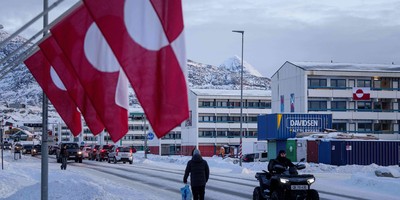When I think of the San Francisco-Oakland Bay Bridge, I think of the decadeslong building of the new eastern span, the shameless political grandstanding for a project that ran $5 billion over budget -- and the construction headaches that live on. Brian Maroney, Caltrans' chief engineer for the bridge, sees something entirely different. He sees a visual stunner that delights drivers as they emerge from Treasure Island to gasp at a skyway with twinkling lights curling toward the East Bay hills. He thrills at the experience to the user, especially at night. Most importantly, he sees a bridge that is safe.
"Thank goodness for construction people," Maroney told me after he gave me a two-hour tour of the new span's shipshape innards. Workers had noticed that a reported 205 of 274 cable rods were off-center. During an earthquake, they might crash into something and kink. That latest bad-news revelation was the basis of a May 16 San Francisco Chronicle story by Jaxon Van Derbeken.
California Gov. Jerry Brown just happened to have an editorial board meeting with the Chronicle the day Van Derbeken's story ran. Of course, I asked Brown about the bridge.
Brown answered, "Life isn't perfect." And: "S--- happens."
Having rattled the governor's cage, I received a phone call from a Caltrans spokesman, who arranged for me to hear Maroney's riff on "shakedown." No, he's not talking about the number done on California taxpayers. "Shakedown" is engineering slang for the settling that occurs as big projects find their angle of repose.
Maroney invited me to tour the bridge. I demurred. He insisted. And thus, on a Friday afternoon, I endeavored to ignore my white-knuckle fear of heights and focused on not looking down as I entered the hard underbelly of the 2.2-mile span.
Recommended
Meanwhile, Maroney gave me a tutorial on bridge engineering. "Shakedown," Maroney explained, "is like you buy a new bicycle and at 30 days you want to retighten your brakes." With a bridge, gravity and heavy truckloads move parts and create the need for adjustment.
Maroney showed me the cable rods, as well as the holes to which some of the rods moved too close since the bridge opened. He sees the problem as eminently solvable.
Was the new span's signature single-anchor suspension design a problem?
Like me, Maroney advocated a simpler bridge -- read: no cables -- that could be built quickly and preferably before an earthquake worse than Loma Prieta, which knocked down a big chunk of the span in 1989. Local officials, however, wanted a showy edifice. The community wanted cables. With cables, more things can go wrong, but a signature span is what the public wanted.
The new span's reputation took a hit in 2013 when workers tightened 96 anchor rods, which had been manufactured in 2008, and 32 cracked. It's never good when a construction project needs a retrofit before it's been open to the public. The state, Maroney noted, decided to put saddles around all 96 rods -- so it's safe, he said.
OK, but Sacramento still needs to repair the damage to the project's credibility.
And though he blames "shakedown" for the cable rod problem, Maroney was clear that the cause of the cracked anchor rods was "not shakedown at all." The culprit there was stress corrosion because of "susceptible" material -- and "an environment" made nasty by water. Something that shouldn't have gone wrong went terribly wrong.
The cost to taxpayers: $25 million.
Now the bridge is open. It's a hit; Maroney is a rock star, and the bridge is his baby. No workers died during construction. The public is jazzed by the beauty of the design. It looks better at night. New steel and state-of-the-art technology make for a safer commute. Bad things happen to good public works, but they're fixable. Don't worry. Be happy.
Another take: Regular bridge commuters already pay an extra $1,000 in higher tolls to fund the new span, so they might as well enjoy it.
Of course, it would be easier to appreciate the bridge if the responsible parties -- instead of commuters -- paid for their mistakes. So far, no contractors or politicians have paid a price.
The lack of urgency displayed by local leaders, including then-Oakland Mayor Jerry Brown, allowed a repair job that should have been completed more than a decade ago to drift. The public's acceptance of what turned into a 24-year construction schedule amplified the feeling that public safety wasn't a top priority in the Bay Area.
When I asked Brown who is responsible for the Bay Bridge, he answered, "The engineers." Harry Truman got it all wrong. The buck stops with the guys in hard hats.























Join the conversation as a VIP Member